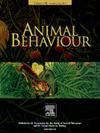运动和个性之间的关系取决于西部菱形背响尾蛇的季节
IF 2.1
2区 生物学
Q2 BEHAVIORAL SCIENCES
引用次数: 0
摘要
行为特征最近被整合到生活节奏综合症假说中,以解释生活史特征的种内变异。然而,这一假设受到了最近荟萃分析中缺乏支持的挑战,提出了关于行为与生活史之间关系的新问题。调查资源获取的种内变异,特别是在自然环境中,一直被忽视,尽管它对理解生活史性状关联很重要。研究了西部菱背响尾蛇个性与空间生态的关系。我们测试了这样的预测:与害羞、不那么活跃、不那么探索的人相比,更大胆、更积极、更有探索性的人移动得更多,拥有的领土也更大。我们对14条响尾蛇进行了为期一年的跟踪研究,并从四个不同的方面评估了它们在圈养状态下的行为:活动、大胆、探索和反应。胆子大的个体比胆子小的个体游得快,但这只发生在非交配季节。在交配季节,害羞个体的运动明显多于大胆个体,从而导致害羞个体和大胆个体在交配季节的运动差异不显著。这些结果表明,运动可能是寻找配偶的最佳策略,而在交配季节,无论性格类型如何,雄性的运动增加可能是提高繁殖成功率的一种选择特征。这些发现强调了人格和动机状态在资源获取(食物和配偶)中的作用。需要进一步的研究来揭示这些策略对该物种的生活史机制和后果。本文章由计算机程序翻译,如有差异,请以英文原文为准。
The relationship between movement and personality is dependent upon the seasons in the western diamond-backed rattlesnake
Behavioural traits have been recently integrated within the pace-of-life syndrome hypothesis to explain intraspecific variations in life-history traits. However, this hypothesis has been challenged by the lack of support found in recent meta-analyses, raising new questions on the relationship between behaviour and life history. Investigating intraspecific variation in resource acquisition, especially in natural settings, has been overlooked despite its importance in understanding life-history trait associations. We investigated the relationship between personality and spatial ecology in the western diamond-backed rattlesnake, Crotalus atrox. We tested the predictions that bolder, more active and exploratory individuals move more and have larger territories compared to shyer, less active, less exploratory individuals. We tracked 14 rattlesnakes for 1 year and assessed their behaviour in captivity across four different axes: activity, boldness, exploration and reactivity. Bolder individuals travelled faster than shyer individuals, but only during the nonmating season. Shyer individuals increased movement significantly more than bolder individuals during the mating season, thus leading to a nonsignificant difference in movement between shy and bold individuals during the mating season. These results suggest that movement might be the best strategy for locating mates and that the increased movement of males during the mating season, regardless of personality type, might be a selected trait to increase reproductive success. These findings highlight the role of personality and motivational state in resource acquisition (food and mates). Further research is required to uncover the life-history mechanisms and consequences of these strategies for this species.
求助全文
通过发布文献求助,成功后即可免费获取论文全文。
去求助
来源期刊

Animal Behaviour
生物-动物学
CiteScore
4.60
自引率
8.00%
发文量
236
审稿时长
10.2 weeks
期刊介绍:
Growing interest in behavioural biology and the international reputation of Animal Behaviour prompted an expansion to monthly publication in 1989. Animal Behaviour continues to be the journal of choice for biologists, ethologists, psychologists, physiologists, and veterinarians with an interest in the subject.
 求助内容:
求助内容: 应助结果提醒方式:
应助结果提醒方式:


